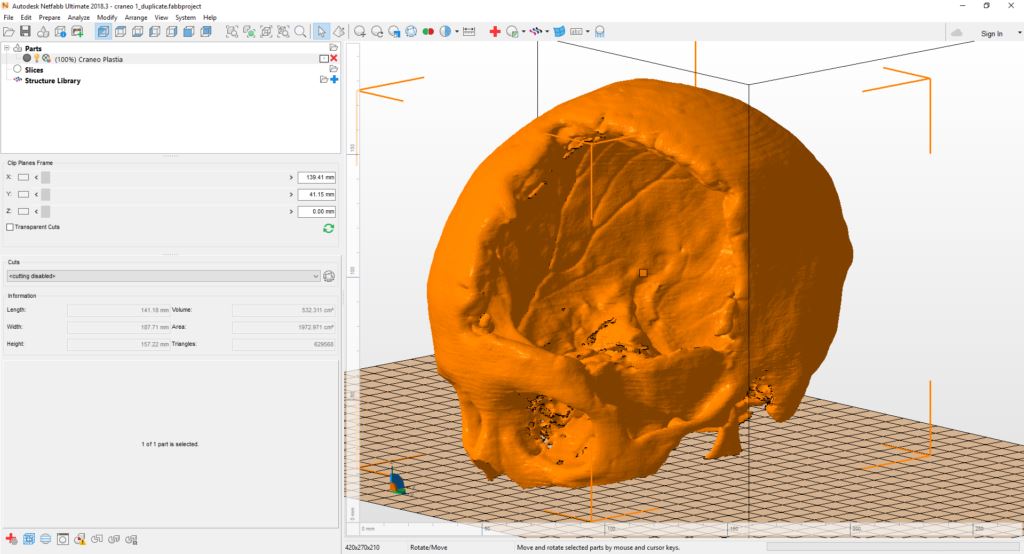![A digital model of Adriana’s skull in Autodesk Netfabb [Image: Autodesk]](https://fabbaloo.com/wp-content/uploads/2020/05/Netfabb-1024x5541_img_5eb099ee5a88d.jpg)
A case study from Autodesk and Granta highlights the technologies put to use in crafting a personalized skull implant.
While many implants have found 3D printing to be a solution, with more biocompatible materials becoming available and gaining FDA approval, perhaps more often the technology is one part of many in the whole process. Patient-specific medical models and prototyping are two major application areas for 3D printing today, and this case study brings them together to help a woman in Mexico.
Adriana Montes de Oca’s life changed forever following a brain aneurysm. After emergency surgery and a craniotomy, she was left with a significant defect in her skull. Skull implants are notoriously difficult, rife with risks of infection or rejection. Her initial cranioplasty, with a PMMA implant, failed, and that implant had to be removed in another emergency surgery.
Mexico City-based Granta is the first company in Mexico to offer custom skull implants, one of very few companies in the world to do so. The young company turned to the Autodesk Foundation to create a new option for Montes de Oca’s next implant, created just for her.
It’s no simple proposition to create a patient-specific implant, though we now hear about these with increasing frequency. Each requires precision in design as well as prototyping, engineering, and manufacturing with all the right tools and materials.
Spoiler alert, as it’s a case study for success: the implant was created well and Montes de Oca is recovering well from her September 2018 surgery. So they found the right tools.
Granta used:
-
A CT scan from the doctor, converted to point cloud data
-
Autodesk Netfabb to clean and prepare the file
-
Autodesk Inventor/Fusion 360 for 3D design
-
3D printed prototype for the surgeon to provide feedback and modifications
-
5-axis CNC, powered by Autodesk Powermill, to create the final PEEK implant
-
Autodesk ReCap to 3D scan and create a virtual model to compare to the original 3D design
![Milling the final PEEK implant [Image: Autodesk]](https://fabbaloo.com/wp-content/uploads/2020/05/IMG_3385-768x5761_img_5eb099eec0d96.jpg)
When it came time to place the implant, the surgical team was prepared for a six-hour procedure. Because the new implant had been designed exactly for this patient’s skull deformation and dimensions, the implant was in place in four minutes.
That’s one of the key benefits of patient-specific design: not molding or shaping the implant during surgery, leaving a patient’s anatomy exposed or prolonging anesthesia. Shorter surgical times save significantly on infection risks as well as operating time.
“At that point everything became so real. Being able to see the implant being fit, being fixed to her skull in less than four minutes, and perfectly without any complications, and they closed it, and when we went out from the surgery room I couldn’t believe it. Everything made sense,” Carlos Monroy, CEO, Granta, said. He saw her the next day in recovery.
“She received me with a huge smile, and said, ‘Thank you for what you have done for me, you have changed my life.’ And in reality, it’s the other way around. I mean the way she changed my life is something that I will always be grateful to her for.”
Montes de Oca was the first patient for Monroy and his team. When he noted that it was life-changing for their perspective as well, he meant it. Granta has since developed 10 custom implants for a variety of patients and needs. One, for example, was for a dog’s foot.
The medical team also appreciated the success of the new technique to create the implant.
“When we placed the implant during surgery, it fit her like a glove. It was very good,” neurosurgeon Dr. Pedro Pablo de Juambelz said. “We are really satisfied with the results and with the technical part of the placement. It helped us a lot to have the custom implant because she had a very large defect. The plate that had been previously placed looked unnatural and, despite our efforts to make it look aesthetic, she was left with a very deformed skull. When patients look in the mirror and don’t look so deformed or so aesthetically affected, it helps them a lot in their emotional recovery and their functional operation.”
Particularly for skull implants, the final look and feel is critical. Cranial deformities can have a profound emotional impact on patients who no longer feel they look like themselves.
“Adriana’s case has filled us with satisfaction, and I think our first choice is to continue using this type of implant in patients who have lost a bone fragment due to any reason, whether in surgery or any other reason. The hospital and our patients will benefit from being at the forefront of the technology,” Dr. de Juambelz said.
Case studies like these are wonderful for a few reasons. First is the obvious: a successful recovery from a difficult medical situation. The human impact is a strong testament to the power of today’s technologies.
Secondly, though, is that 3D printing wasn’t the focus. Sometimes we can get a little bubbled up in reporting on all the powers and applicability of 3D printing, or get caught up with focus on production usage and become inclined to downplay prototyping. Prototyping, though, remains a significant mainstay in nearly every application for 3D printing — and in some cases can be effectively a life-saver. Literally.
The place of 3D printing in realistic workflows is to complement other processes and practices. As the Granta team recognized, it’s about using the best tool for the job. And 3D printing is a powerful, but not universal, tool.
![A look from Granta showing before/during/after images [Images: Autodesk]](https://fabbaloo.com/wp-content/uploads/2020/05/Granta_img_5eb099ef34be7.gif)
For more on this use case Autodesk Redshift offers a video here:
Granta’s Custom Skull Implants Break the Mold for Head Trauma Treatment
Via Granta and Autodesk News











FELIXprinters has released a new bioprinter, the FELIX BIOprinter, which is quite a change for the long-time 3D printer manufacturer.